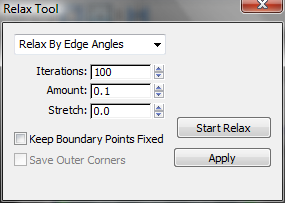 Command entry:Unwrap UVW modifier
Command entry:Unwrap UVW modifier  Edit UVs rollout
Edit UVs rollout  Click Open UV Editor button.
Click Open UV Editor button.  Edit UVWs dialog
Edit UVWs dialog  Tools menu
Tools menu  Relax
Relax
 Command entry:Unwrap UVW modifier
Command entry:Unwrap UVW modifier  Edit UVs rollout
Edit UVs rollout  Open UV Editor button
Open UV Editor button  Edit UVWs dialog
Edit UVWs dialog  Reshape Elements rollout
Reshape Elements rollout 
 Relax Settings button (on Relax: Custom flyout)
Relax Settings button (on Relax: Custom flyout)
The Relax Tool dialog offers an advanced toolset for modifying the spacing of selected texture coordinates parametrically, for the purpose of eliminating or minimizing distortion in texture maps.
The dialog provides three different methods for relaxing vertices, plus several numeric parameters and two check boxes. You can use Relax to separate texture vertices that are too close together to texture easily, and to resolve overlapping areas.
The dialog is non-modal, which means that you can work directly in the editor while keeping the dialog open. You can make a selection of texture vertices, apply relaxation, make a different selection, apply relaxation, and so on, without having to close the Relax Tool dialog.
 Expand Selection
Expand Selection  Detach Edge Verts will break the selection away from the mesh into a new UV element.
Detach Edge Verts will break the selection away from the mesh into a new UV element.
 Effective use of the Relax tools requires that the geometry and texture vertices be in the same order. If you get unexpected
results using Relax, try mirroring the texture vertices to reverse their order.
Effective use of the Relax tools requires that the geometry and texture vertices be in the same order. If you get unexpected
results using Relax, try mirroring the texture vertices to reverse their order.
You can make this selection at any sub-object level (Vertex, Edge, or Face), but Relax always works on vertices.
 (Relax Until Flat) on the Reshape Elements rollout of the Edit UVWs dialog. Click that, and if it does the job, you're finished.
(Relax Until Flat) on the Reshape Elements rollout of the Edit UVWs dialog. Click that, and if it does the job, you're finished.
If not, undo (Ctrl+Z) and open the Relax Tool dialog by following either UI path at the start of this topic.

The default method is Relax By Edge Angles; this usually gives the best results.
As the relaxing progresses, a message appears showing you which frame is being processed. A frame is equivalent to an iteration.
The appropriate relax method and other settings depend on a variety of conditions, including the complexity and topology of the mesh, so experimentation is usually required. Relaxing is undoable, so if one method doesn't work, undo and try another.
To use Relax to fix overlapping faces:
This procedure provides general guidelines for resolving overlapping texture faces. It might not work in every case, but it should give you a starting point for correcting most situations.
 (Polygon Sub-object Mode).
(Polygon Sub-object Mode).
 Select menu, choose Select Overlapped Faces.
Select menu, choose Select Overlapped Faces.
 (Grow: UV Selection) to select faces surrounding the overlapping faces.
(Grow: UV Selection) to select faces surrounding the overlapping faces.
This gives the overlapping faces a larger area in which to spread out.
If this seems to help, continue clicking Apply, or just click Start Relax, and wait until the overlapping is resolved. If not, undo (Ctrl+Z) and try using Relax By Face Angles instead, or increase the Amount value, or change the Stretch value, or use combinations of the above.

The method used to relax the texture vertices. Choose from the drop-down list:
Controls whether vertices at the outer edges of the texture coordinates are moved. Default=off.
When off, the outer edge of the texture mesh can float, allowing a wider range of the available texture-mapping space to be used. Typically you would keep this off when relaxing an entire element or cluster, so 3ds Max can minimize distortion by moving the edges.
When relaxing an interior subset of vertices, it is recommended you turn this on to prevent the selected vertices from overlapping unselected vertices. For Relax By Edge and Face Angles, turn this off until you get a good solution for the outer boundaries of the mesh and then turn it on to resolve the interior sections.
Initiates the relax process on a continuous basis, ignoring the Iterations setting. During this time, you can change the other dialog settings and see the results in real time.
To halt the relax process, click outside the dialog, press Esc, or click the same button (“Stop Relax”). To revert to the previous mapping, use Undo (Ctrl+Z).
Begins the relaxation process using the current settings. As relaxation takes place, a textual progress indicator appears at the bottom of the dialog, showing the current iteration (Process frame) and the total number of iterations being processed.
To abort the relaxation process, press Esc. You can then use Undo (Ctrl+Z) to return to the prior state, if necessary.